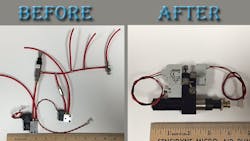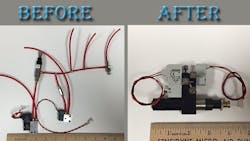How to Increase Efficiency by Simplifying Pneumatics
Assembling pneumatic systems can be a laborious exercise. An OEM worker connects off-the-shelf components like valves and manifolds with a series of tubes. They thread the fittings, then push the slim tubing, which may have to be cut into that. After that, they run the air line to the next component and repeat until the circuit is completed. Then they troubleshoot and fix any issues.
Pneumadyne, a subsidiary of Bimba Manufacturing, advocates simplifying the process by installing completed air circuits, pre-made by another manufacturer, into the system. Of course they are going to advocate that, because they just so happen to make these circuits. But it’s hard to argue with the logic. The company reports that a medical manufacturer slashed assembly time from 40 min. to 5 min.
Photos by Pneumadyne
The company says reducing a tubing run length from 15 to 2 ft can reduce air volume by 80%, so the compressor size can also be smaller.
The actual system will be highly more efficient, too, because leakage at threaded joints is eliminated, because those parts are eliminated.
“In typical manufacturing environments, pneumatic systems inherently lose 30-35% due to air leakage from fittings or seals,” explains John Schmidt, director of operations at Pneumadyne.
We asked Schmidt about who may need these completed circuits and how they are made.
NED: So how does an OEM know if they should look into this solution?
Schmidt: Is your current system riddled with pipe thread connections and a big rat’s nest of tubing or do you have a wiring disaster? It can be packaged in a much tidier, efficient manner. If there’s any scale to the product, looking to consolidate the components into a plug and play and play system is in their best interest and minimize the amount of suppliers to work with. You have a single source solution. And they don’t have to spend the time testing and troubleshooting. They can focus on what they’re best at.
What should a client know prior to seeking out a company to produce their completed pneumatic circuits? In a lot of times, the amount of money spent on assembly of system is just chalked up as overhead. They’re only looking at materials costs. How long does it take to put these things together?
They should also be able to answer what the system needs to do, and know the pressure, flow requirements, voltage, and target cost. Defining all these parameters upfront is crucial to provide the best solution possible
Can you walk us through how Pneumadyne would help an OEM get that best solution possible?
Our team of application engineers will identify any pain points in the current system, or if it’s a new system, find out the requirements and where we’ll be placed on the piece of equipment. They’ll define external connection types, sizes and orientations, to get a baseline and best locate the circuit to minimize the size of it and tubing runs, and make it as efficient as possible.
How is the production development process worked out?
We’ll utilize GoToMeeting all the time to present the CAD data. We do the preliminary designs in SolidWorks. Being able to meet virtually really expedites the process. It usually goes through a couple different iterations, Initial model spurs good conversation about what our vision of the system looks like vs. what they had in their mind that we may or may not have extracted.
Do you use any advanced manufacturing?
We utilize a 3d printer to create models to put in their hand for fit and function. A virtual model just isn’t enough for some people. This gives them something tactile to put in their hands which they can set next to the rest of their system and make decisions off of. They will say, “Oh I didn’t see the interference here.”
How are they made?
We do most of the manufacturing in Plymouth, Minn. in our assembly dept. We’re going to design, build and test these solutions all in one facility here. That helps us design for manufacturability, because are engineers are working directly with our programmers, our machinists and assemblers throughout the design phase.
We put a lot of investment in high-end CNC technology for making these products to a high quality standard. We use Mazak and Haas CNC equipment, and a Mazak flexible machining system.
Once the circuit is made, then what?
We ship them out to the facility. Our largest system is the size of at a 13-in. cube. They’ll install and connect the air and electrical hookups, do the testing and provide feedback. They should be up and running in a matter of minutes. And it should run for millions of cycles.
About the Author
John Hitch
Editor, Fleet Maintenance
John Hitch, based out of Cleveland, Ohio, is the editor of Fleet Maintenance, a B2B magazine that addresses the service needs for all commercial vehicle makes and models (Classes 1-8), ranging from shop management strategies to the latest tools to enhance uptime.
He previously wrote about equipment and fleet operations and management for FleetOwner, and prior to that, manufacturing and advanced technology for IndustryWeek and New Equipment Digest. He is an award-winning journalist and former sonar technician aboard a nuclear-powered submarine where he served honorably aboard the fast-attack submarine USS Oklahoma City (SSN-723).


